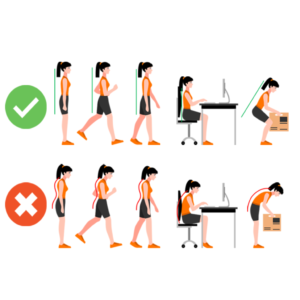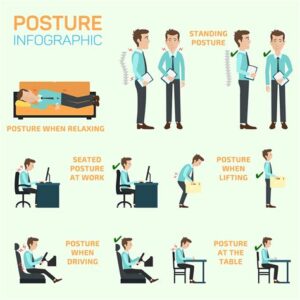Back to: Physical and Health Education JSS 2
Welcome to class!
In today’s class, we shall be talking about the Characteristics of good postures. Please enjoy the class!
Characteristics of Good Postures

Let’s face it, we’ve all been there: hunched over a computer screen, shoulders slumped like melting ice cream, phone clutched in a death grip. But what if I told you that slouching wasn’t just a bad habit, but a silent saboteur of your health, happiness, and even confidence? That’s where the magic of good posture comes in!
Imagine this: You stand tall, shoulders back and chin held high. Your spine isn’t a question mark, but a proud exclamation point. Your breath flows freely, your muscles feel energized, and you radiate an aura of self-assurance. That’s the power of good posture, and here’s why it deserves a starring role in your life:
- Pain Relief: Slouching is like asking your back muscles to hold up a bowling ball with a wet noodle for a spine. No wonder backaches become our unwelcome companions. Good posture distributes your weight evenly, taking the pressure off your spine and alleviating pain in your back, neck, and shoulders.

- Breathe Easy: When you hunch, your lungs get squashed like accordion gone wrong. Not cool for optimal oxygen intake! Good posture opens up your chest cavity, allowing your lungs to expand fully and fill you with the sweet nectar of life – air!
- Energy Booster: Slouching is like carrying an invisible backpack full of bricks. Good posture, on the other hand, is like shedding that burden. Your muscles work efficiently, your blood circulates freely, and you feel a surge of energy that can power you through your day.
- Confidence Catalyst: Stand tall, and the world takes notice. Good posture is a nonverbal language that screams confidence, competence, and self-respect. It can even influence how others perceive you, making you appear more approachable and trustworthy.
- Mood Master: Ever felt grumpy after a slouch session? Turns out, there’s a connection! Good posture has been shown to boost mood and reduce stress, while slouching can contribute to feelings of anxiety and depression. So, straighten up and smile – your brain will thank you!
- Injury Prevention: Slouching puts your joints and muscles in awkward positions, making them vulnerable to injury. Good posture, on the other hand, keeps your body aligned and balanced, reducing your risk of sprains, strains, and even chronic pain.
- Performance Powerhouse: Whether you’re a gym rat or a weekend warrior, good posture is your secret weapon. It improves your balance, coordination, and range of motion, helping you perform at your peak in any physical activity.
Remember, good posture is a journey, not a destination. Here are some tips to cultivate this superpower in your daily life:

- Mind your posture: Actively check your posture throughout the day. Are your shoulders back? Chin up? Spine straight?
- Strengthen your core: A strong core is the foundation of good posture. Exercises like planks and bridges can work wonders.
- Stretch it out: Tight muscles can pull your posture out of whack. Regular stretching keeps your body limber and aligned.
- Ergonomics matter: Set up your workspace to support good posture. Invest in an adjustable chair and monitor height, and take breaks to move around.
- Be mindful of technology: Don’t let your phone become a neck-wrecking machine! Hold it at eye level and take breaks from screens.
With a little dedication, you can transform your slouch into a strut and reap the amazing benefits of good posture. So, stand tall, breathe deep, and embrace the power of a spine that says, “I’ve got this!”
Question Time:
Section A :
- Which of the following is NOT a benefit of good posture?
- a) Reduced back pain
- b) Improved breathing
- c) Increased confidence
- d) More attractive appearance
- When slouching, your lungs:
- a) Expand more efficiently
- b) Become compressed and function less effectively
- c) Remain unaffected
- d) Increase oxygen intake
- Good posture can have a positive impact on your:
- a) Physical health only
- b) Mental health only
- c) Physical and mental health
- d) Social interactions only
- To improve your posture, it is important to:
- a) Sit for long periods without breaks
- b) Strengthen your core muscles
- c) Hunch your shoulders forward
- d) Avoid stretching exercises
- Which of the following resources is NOT mentioned in the passage for further learning about posture?
- a) TED Talk by Amy Cuddy
- b) Posture Reminder app
- c) Yoga classes
- d) The Art of Manliness website
Section B (Essay Questions):
- Discuss the various physical and mental health benefits of maintaining good posture. Use specific examples to support your arguments.
- Explain how good posture can positively impact your confidence and interpersonal relationships. Share any personal experiences or observations you have related to this topic.
- Describe some practical strategies you can implement in your daily life to improve and maintain good posture. Discuss the challenges you might face and how you would overcome them.
- Compare and contrast the posture habits of young people today with those of previous generations. Analyze the potential contributing factors and potential consequences of these differences.
